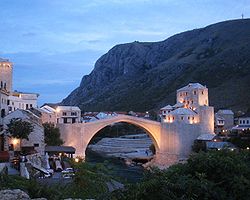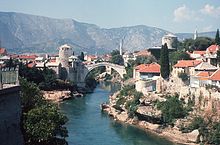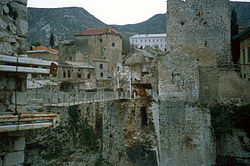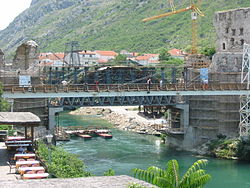- Stari Most
-
This article is about Stari Most in Mostar, Bosnia and Herzegovina. For the former Old Bridge, Ljubljana, Slovenia, see Triple Bridge.
Stari Most 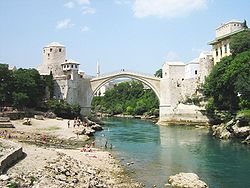
Official name Stari most Carries Pedestrians Crosses Neretva Locale Mostar, Bosnia and Herzegovina Design Arch Total length 29 metres Width 4 metres Clearance below 20 metres at mid-span Opened 1566/1567/2004 Official name: Old Bridge Area of the Old City of Mostar Type: Cultural Criteria: vi Designated: 2005 (29th session) Reference #: 946 State Party:  Bosnia and Herzegovina
Bosnia and HerzegovinaRegion: Europe and North America Stari Most (English: Old Bridge) is a 16th century Ottoman bridge in the city of Mostar, Bosnia and Herzegovina that crosses the river Neretva and connects two parts of the city. The Old Bridge stood for 427 years, until it was destroyed on November 9, 1993 during the Croat-Bosniak War. Subsequently, a project was set in motion to reconstruct it, and the rebuilt bridge opened on July 23, 2004.
Contents
Location
The bridge spans the Neretva river in the old town of Mostar, the city to which it gave the name. The city is the fourth-largest in the country; it is the center of the Herzegovina-Neretva Canton of the Federation of Bosnia and Herzegovina, and the unofficial capital of Herzegovina.
Characteristics
The Stari Most is hump-backed, 4 metres (13 ft 1 in) wide and 30 metres (98 ft 5 in) long, and dominates the river from a height of 24 m (78 ft 9 in). Two fortified towers protect it: the Helebija tower on the northeast and the Tara tower on the southwest, called "the bridge keepers" (natively mostari).
The arch of the bridge was made of local stone known as tenelija. The shape of the arch is the result of numerous irregularities produced by the deformation of the intrados (the inner line of the arch). The most accurate description would be that it is a circle of which the centre is depressed in relation to the string course.
Instead of foundations, the bridge has abutments of limestone linked to wing walls along the waterside cliffs. Measuring from the summer water level of 40.05 m (131 ft 5 in), abutments are erected to a height of 6.53 metres (21 ft 5 in), from which the arch springs to its high point. The start of the arch is emphasized by a molding 0.32 metres (1 ft 1 in) in height. The rise of the arch is 12.02 metres (39 ft 5 in).
History
Construction
The original bridge was commissioned by Suleiman the Magnificent in 1557 to replace an older wooden suspension bridge of dubious stability. Construction began in 1557 and took nine years: according to the inscription the bridge was completed in 974 AH, corresponding to the period between July 19, 1566 and July 7, 1567. Little is known of the building of the bridge, and all that has been preserved in writing are memories and legends and the name of the builder, Mimar Hayruddin (student of Mimar Sinan, the Ottoman architect). Charged under pain of death to construct a bridge of such unprecedented dimensions, the architect reportedly prepared for his own funeral on the day the scaffolding was finally removed from the completed structure. Upon its completion it was the widest man-made arch in the world. Certain associated technical issues remain a mystery: how the scaffolding was erected, how the stone was transported from one bank to the other, how the scaffolding remained sound during the long building period. As a result, this bridge can be classed among the greatest architectural works of its time.
According to the 17th century Turkish traveler Evliya Çelebi, the name Mostar itself means "bridge-keeper." As Mostar's economic and administrative importance grew with the growing presence of Ottoman rule, the precarious wooden suspension bridge over the Neretva gorge required replacement. The old bridge on the river: "Was made of wood and hung on chains," wrote the Ottoman geographer Katip Çelebi, and it "swayed so much that people crossing it did so in mortal fear". In 1566, Mimar Hayruddin, a student of the great architect Sinan, designed Stari Most. During the reign of, Suleyman the Magnificent, the bridge, which was said to have cost 300,000 Drams (silver coins) to build, The two-year construction project was supervised by Karagoz Mehmet Bey, Sultan Suleyman's son-in-law and the patron of Mostar's most important mosque complex, called the Hadzi Mehmed Karadzozbeg Mosque.
The bridge, 28 meters long and 20 meters high (90' by 64'), quickly became a wonder in its own time. The famous traveler Evliya Çelebi wrote in the 17th century that: the bridge is like a rainbow arch soaring up to the skies, extending from one cliff to the other. ...I, a poor and miserable slave of Allah, have passed through 16 countries, but I have never seen such a high bridge. It is thrown from rock to rock as high as the sky.[1]
Destruction
The Old Bridge stood for 427 years, until it was destroyed on 9 November 1993 during the War in Bosnia and Herzegovina. After its destruction a temporary cable bridge was erected in its place.
Responsibility for the destruction of the bridge is attributed to Bosnian Croat artillery fire.[2][3][4] Starting on 8 November 1993 the Croatian Defence Council (HVO) bombarded the bridge. Sarajevo-based newspapers reported that more than sixty shells hit the bridge before it collapsed.[5] After the destruction of the Stari Most, a spokesman for the Croats admitted that they deliberately destroyed it, claiming that it was of strategic importance.[6] Academics have argued that the bridge held little strategic value and that its shelling was an example of deliberate cultural property destruction. Andras Riedlmayer terms the destruction an act of "killing memory", in which evidence of a shared cultural heritage and peaceful co-existence were deliberately destroyed.[5]
Slobodan Praljak, the commander of the Croatian Defence Council, is currently on trial at the ICTY with the prosecution alleging that he ordered the destruction of the bridge, among other charges.[7][8]
Reconstruction
After the end of the war, plans were raised to reconstruct the bridge. The World Bank, the United Nations Educational, Scientific and Cultural Organization (UNESCO), the Aga Khan Trust for Culture and the World Monuments Fund formed a coalition to oversee the reconstruction of the Stari Most and the historic city centre of Mostar.[9] Additional funding was provided by Italy, the Netherlands, Turkey, Croatia and the Council of Europe Development Bank, as well as the Bosnian government.[9] In October 1998, UNESCO established an international committee of experts to oversee the design and reconstruction work.[9] It was decided to build a bridge as similar as possible to the original, using the same technology and materials.[9] The bridge was built with local materials. Tenelia stone from local quarries was used and Hungarian army divers recovered stones from the original bridge from the river below.[9] Reconstruction commenced on 7 June 2001. The reconstructed bridge was inaugurated on 23 July 2004.[9]
Diving
It is traditional for the young men of the town to leap from the bridge into the Neretva. As the Neretva is very cold, this is a very risky feat and only the most skilled and best trained divers will attempt it. The practice dates back to the time the bridge was built, but the first recorded instance of someone diving off the bridge is from 1664. In 1968 a formal diving competition was inaugurated and held every summer. The first person to jump from the bridge since it was re-opened was Enej Kelecija, a local who now resides in the United States.[10]
In popular culture
- Smrt Gospodina Goluže - movie by Živko Nikolić
See also
- History of Bosnia and Herzegovina
- Tourism in Bosnia and Herzegovina
- Museum of the Old Bridge
- List of World Heritage Sites in Bosnia and Herzegovina
References
- ^ http://www.saudiaramcoworld.com/issue/199805/hearts.and.stones.htm
- ^ Traynor, Ian (July 24, 2004). "Mostar reclaims Ottoman heritage". The Guardian (London). http://www.guardian.co.uk/world/2004/jul/24/iantraynor. Retrieved May 24, 2010.
- ^ Woodard, Colin (2000). "Bosnia: Stillborn". Bulletin of the Atomic Scientists 56 (5): 17–19. doi:10.2968/056004006.
- ^ Grodach, Carl (2002). "Reconstituting identity and history in post-war Mostar, Bosnia-Herzegovina". City 6 (1): 61–82. doi:10.1080/13604810220142844.
- ^ a b Coward, Martin (2009). Urbicide: The Politics of Urban Destruction. London: Routledge. pp. 1–7. ISBN 0415461316. http://books.google.co.uk/books?id=vVvzcTqH5iMC&lpg=PA6&dq=stari%20most%20hvo&pg=PA1#v=onepage&q&f=false.
- ^ Borowitz, Albert (2005). Terrorism for self-glorification: the herostratos syndrome. Kent State University Press. pp. 65. ISBN 0873388186.
- ^ "PRLIĆ et al. (IT-04-74)". Case Information Sheet. ICTY. http://www.icty.org/x/cases/prlic/cis/en/cis_prlic_al_en.pdf. Retrieved January 17, 2010.
- ^ Del Ponte, Carla (March 2, 2004). "The Prosecutor of the Tribunal against Jadranko Prlic, Bruno Stojic, Slobodan Praljak, Milivoj Petkovic, Valentin Coric and Berislav Pusic: Indictment". ICTY. http://www.icty.org/x/cases/prlic/ind/en/prl-ii040304e.htm. Retrieved January 17, 2010.
- ^ a b c d e f Armaly, Maha; Blasi, Carlo; Hannah, Lawrence (2004). "Stari Most: rebuilding more than a historic bridge in Mostar". Museum International 56 (4): 6–17. doi:10.1111/j.1468-0033.2004.00044.x.
- ^ http://www.pluska.sk/showdoc.do?docid=12602&showRate=true
External links
- Rehabilitation Design of the Old Bridge of Mostar
- Bosnia and Herzegovina Commission for Preservation of National Monuments - The Stari Most
- Before, during and after destruction, pictures taken by Belgian photographer Laurent Van der Stockt - Time magazine
- Live webcams from Stari most and the Old town. (mirror)
World Heritage Sites in Bosnia and Herzegovina Mehmed Paša Sokolović Bridge · Stari most
Coordinates: 43°20′13.568639″N 17°48′53.387639″E / 43.33710239972°N 17.81482989972°E
Categories:- World Heritage Sites in Bosnia and Herzegovina
- Ottoman bridges in Bosnia and Herzegovina
- Buildings and structures in the Federation of Bosnia and Herzegovina
- Bosnia and Herzegovina architecture
- Demolished bridges
- Destroyed landmarks
- Deck arch bridges
- Mostar
- Bridges completed in the 1560s
- Stone bridges
- Bridges completed in 2004
Wikimedia Foundation. 2010.

